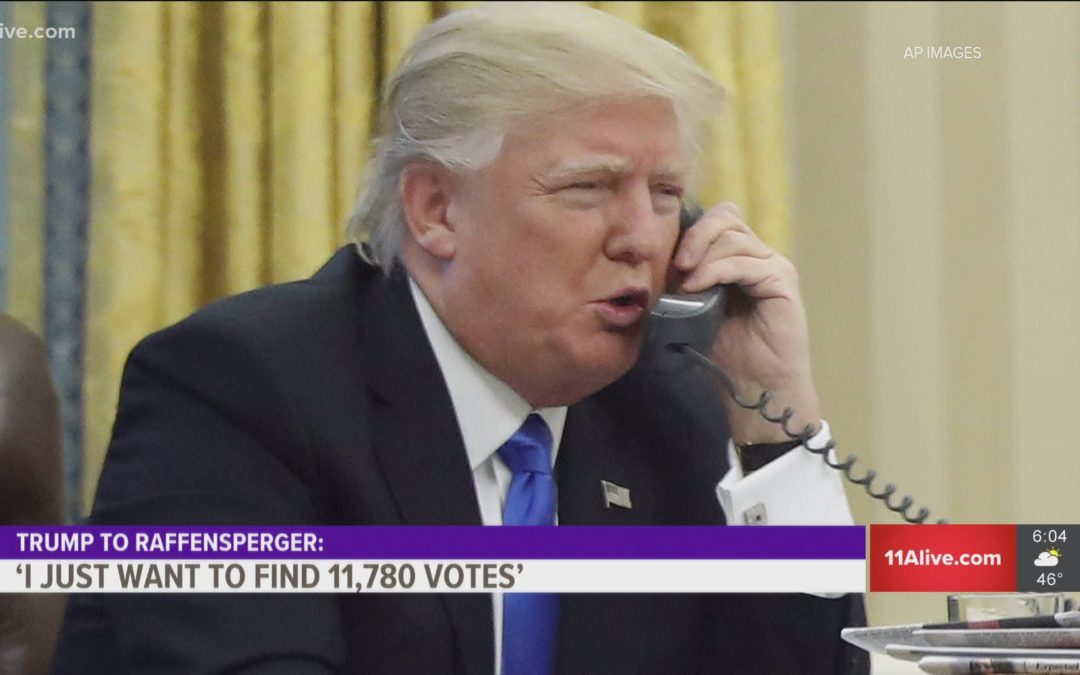I have a confession. I listened to the “Trump Tapes,” the call with Georgia’s Secretary of State Brad Raffensperger where the president tries to coerce him to doctor the state’s presidential race results to flip the state for Trump. You can listen to the conversation here.
But that’s not my confession.
My admission is that part of me could believe Trump.
His confidence. The numbers he cited. The absurdity that someone could make up all those numbers and allegations, and do so with a straight face. The corroboration from his lawyer/s on the phone call.
Yet, because I reasonably certainly know Trump to be a delusional, pathological liar, and after hearing yet another rebuttal to Trump’s allegations by Raffesnperger, I ended up merely in awe listening to DJT’s diatribe of disinformation. But I gave him the benefit of the doubt on some of his assertions I had not yet heard debunked. Thankfully, this discrediting was not far off. Props to Raffensperger for calmly stating the facts to Mr. Trump: that his assertions are false—the way many of us have tried to share with Covid deniers, Trumpers, and QAnoners.
This is why resolving disputes, and navigating reality honestly, comes down to evidence. Evidence shows what is true, most of the time. Therefore, establishing good evidence is crucial. This is why conspiracists do two primary things to destroy the truth and prop up an alternate reality: they attack reliable sources of evidence (journalism, science, intellectualism) and they assert their own story with false data, or no data, and rely on charisma, bullying, and logical fallacies such as an appeal to emotion or an appeal to authority (do yourself a favor and brush up on learning logical fallacies as regularly as you wash your dog!). We have watched Trump, QAnoners, and Covid-deniers and anti-maskers do this all year long, and longer.
What provides good evidence, or how we know what we know to be most likely true—is so important. And this is why I wrote an essay about how to determine what is most likely true (what is called “epistemology”), that I urge you to read. It is here.
Trump also exerts cult tactics, because his whole movement is a cult. To convert believers, cult leaders rely on a few basic strategies to dissuade followers from their sovereignty in order to be manipulate them. One is to make them believe that they are sheep and being manipulated if they believe reliable, established sources of ascertaining the truth (this is the great irony!). A second is to sound unflinchingly convincing, powerful, and sure of one’s knowledge. A third is to assert lies with charisma. A fourth is to threaten, to instill fear if one doesn’t follow or obey the alternate facts. A fifth is to manipulate and pressure one to cave in by calling in other sources to support the disinformation. A sixth is to use charisma to persuade. Trump exercised all these in his call with Raffensperger,
You can’t just make shit up. Well, actually you can, and that is what conspiracists and cult leaders do. And they develop a parallel universe set of justifications and stories about reality to support those false beliefs.
Trump also alternated among condescension (calling Raffensperger a child), placating (paraphrased: “there’s nothing wrong with saying you found the votes we needed”), bargaining (come on, can’t we find something), threatening (warning there will be criminal consequences for not satisfying trump’s wishes), and abuse (for example, insinuating Raffensperger is a child or threatening punishment, much like Trump did on the Ukraine call). See what I did there? I provided evidence, and there are more examples on the recording.
Lucky for us, Raffensperger is no pushover, the way so many conspiracists and deniers are. Which brings us to a takeaway: become solid in your epistemology, in your wisdom for how to discern the truth, or what is more likely true. Notice I am not saying “Become solid in your conclusions,” which is too narrow-minded and likely dishonest. I am saying “Become solid in your means for discovering what is most likely true.” And for this I encourage you to read this essay.
The whole phone call was one long gaslighting session: trying to convince Raffensperger that he is wrong and delusional, which trump tries to achieve by exercising brainwashing and manipulative tactics from the cultist’s playbook.
Back to my confession: Part of me could believe Trump’s assertions on that phone call. One reason is that I try to listen for facts and cogency, while dismissing my preconceived bias. Yet, because I know that Trump disavows the truth and has little grasp on reality, I give him a very short leash on benefit of doubt. Second, I could see how part of me could be tentatively swayed, to a small degree, for all the previous reasons stated: his confident tone, the exact figures he throws out, his smooth and charismatic delivery. Until I heard Raffensperger reply that all Trump’s allegations have been investigated and found to be false, which I had heard before to a degree, but in less detail.
It’s therefore no wonder that so many have become Trump supporters, have gone down the QAnon rabbit hole, and have eschewed masks and social distancing. A shaky, or non-existent, foundation for knowing what’s more likely true is at the root of our cultish crises.
Yet, learning what’s true isn’t simply about recognizing what’s true, or learning how to discover what’s true. Emotional bias, I believe, plays an even larger role than mere cognitive awakening. This deeper, primal drive to deny what’s true and to believe what’s untrue hinges on fear in many different disguises and manifestations—which, by the way, *is not* the popular conspiracist narrative that “fear is bad” and to be avoided. For example, consider that if we don’t have a stomach for difficult reality, this fear will drive us to want to believe something else. I discuss these crucial fear dynamics here
So, if we are to going to turn our country around, we are going to need a lot more self, and collective, empowerment, which tools I offer in The Healing of America.


